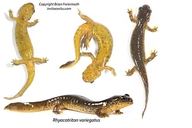|
Rhyacotriton variegatus Stebbins & Lowe, 1951
Southern Torrent Salamander | family: Rhyacotritonidae genus: Rhyacotriton |
| Species Description: Stebbins RC and Lowe Jr, CH. 1951. Subspecific differentiation in the Olympic salamander Rhyacotriton olympicus. University of California Publications in Zoology 50: 465–484 | |
 © 2015 Brian Freiermuth (1 of 68) |
|
|
|
Description Dorsum is brown to greenish-brown, and the underside is bright yellow. Variable degree of black speckling on both dorsal and ventral surfaces (Leonard et al. 1993; Petranka 1998). Distribution and Habitat Country distribution from AmphibiaWeb's database: United States U.S. state distribution from AmphibiaWeb's database: California, Oregon
The habitat of southern torrent salamanders is forested areas, with high humidity and dense canopy cover (Welsh and Lind 1996). Individuals are found near seepages and small streams, preferring to occupy the splash zone of cool, turbulent streams with small boulders and very little fine sediment. Adults are rarely found more than a meter from the streams edge (Leonard et al. 1993; Welsh and Lind 1996). Life History, Abundance, Activity, and Special Behaviors Females may oviposit at any time of the year, but tend to lay in late spring (Nussbaum and Tait 1977). In other species of Rhyacotriton, egg deposition sites are in seeps at the heads of springs and this is likely to be similar in R. variegatus (Nussbaum 1969). Clutch size ranges from 2 to 16 (Stebbins and Lowe 1951; Stebbins 1985). In a nest of the closely related species R. kezeri at least three females may have laid their eggs communally (Nussbaum 1969). There is apparently no attendance of the developing eggs (Nussbaum 1969; Nussbaum and Tait 1977). Clutch frequency is once per year (Nussbaum and Tait 1977; Nussbaum et al. 1983). Eggs laid in spring hatch 5-6 months later (Nussbaum 1969). Southern populations are thought to oviposit earlier than northern populations (Stebbins and Lowe 1951). Larvae metamorphose in 2-2.5 years and are sexually mature 1-1.5 years later (Petranka 1998). Adults and juveniles feed primarily on aquatic and semiaquatic invertebrates, including amphipods, collembolans, stoneflies, mayflies, beetles, flies, spiders, snails, oligochaetes, and hymenopterans. Natural predators have not been documented but larval and adult Pacific Giant salamanders (Dicamptodon) are probably important. See Petranka (1998) and references therein. Rhyacotriton respond to attacks by coiling the body and raising and undulating the tail which contains poison glands (Nussbaum et al. 1983). Rhyacotriton variegatus may be locally abundant, with combined adult and larval densities estimates ranging from 0.18-5.5 animals/m2 (Diller and Wallace 1996; Welsh and Lind 1996) to as high as 14-22 animals/m2 (Welsh and Lind 1992) in northern California populations. In an Oregon population, larvae were estimated at 13 larvae/m2 (Nussbaum and Tait 1977). Larva Trends and Threats Comments See another account at californiaherps.com.
References
Bury, R. B. (1983). "Differences in amphibian populations in logged and old growth redwood forest." Northwest Science, 57, 167-178. Corn, P. S. and Bury, R. B. (1989). ''Logging in Western Oregon: responses of headwater habitats and stream amphibians.'' Forest Ecology and Management, 29, 39-57. Diller, L. V. and Wallace, R. L. (1996). ''Distribution and habitat of Rhyacotriton variegatus on managed, young growth forests in north coastal California.'' Journal of Herpetology, 30, 184-191. Good, D. A., Wake, D. B., and Wurst, G. Z. (1987). ''Patterns of geographic variation in allozymes of the Olympic salamander Rhyacotriton olympicus (Caudata: Dicamptodontidae).'' Fieldiana, Zoology, 32, 1-15. Good, D. A., and Wake, D. B. (1992). ''Geographic variation and speciation in the torrent salamanders of the genus Rhyacotriton (Caudata: Rhyacotritonidae).'' University of California Publications in Zoology, 126, 1-91. Leonard, W.P., Brown, H.A., Jones, L.L.C., McAllister, K.R., and Storm, R.M. (1993). Amphibians of Washington and Oregon. Seattle Audubon, Seattle. Nussbaum, R. (1969). ''A nest site of the Olympic Salamander, Rhyacotriton olympicus (Gaige).'' Herpetologica, 25, 277-278. Nussbaum, R. A., Brodie, E. D., Jr., and Storm, R. M. (1983). Amphibians and Reptiles of the Pacific Northwest. University of Idaho Press, Moscow, Idaho. Nussbaum, R., and Tait, C. K. (1977). ''Aspects of the life history and ecology of the Olympic Salamander, Rhyacotriton olympicus.'' American Midland Naturalist, 98, 176-199. Petranka, J. W. (1998). Salamanders of the United States and Canada. Smithsonian Institution Press, Washington D.C. and London. Sever, D M. (1988). "Male Rhyacotriton olympicus (Dicamptodontidae: Urodela) has a unique cloacal vent gland." Herpetologica, 44, 274-280. Stebbins, R. C. (1985). A Field Guide to Western Reptiles and Amphibians. Houghton Mifflin, Boston. Stebbins, R.C., and Lowe, C.H., Jr. (1951). ''Subspecific differentiation in the Olympic salamander Rhyacotriton olympicus.'' University of California Publications Zoology, 50, 465-484. Welsh, H. H., Jr. and Lind, A. J. (1991). ''The structure of the herpetofaunal assemblage in the Douglas-fir/hardwood forests of northwestern California and southwestern Oregon.'' Wildlife and Vegetation of Unmanaged Douglas-fir Forests, USDA Forest Service, General Technical Report PNW-GTR-285. L. F. Ruggiero, K. B. Aubry, A. B. Carey, and M. H. Huff, eds., USDA Forest Service, 394-413. Welsh, H. H., Jr., and Lind, A. J. (1992). ''Population ecology of two relictual salamanders from the Klamath Mountains of northwestern California.'' Wildlife 2001: Populations. McCullough, D.R., and R.H. Barrett, eds., Elsevier Applied Science, New York., 419-437. Welsh, H. H., Jr., and Lind, A. J. (1996). ''Habitat correlates of the southern torrent salamander, Rhyacotriton variegatus (Caudata: Rhyacotritonidae), in northwest California.'' Journal of Herpetology, 30, 385-398. Originally submitted by: Meredith J. Mahoney and Lauren M. Chan (first posted 1999-02-16) Edited by: Meredith J. Mahoney, Michelle S. Koo (2023-01-08) Species Account Citation: AmphibiaWeb 2023 Rhyacotriton variegatus: Southern Torrent Salamander <https://amphibiaweb.org/species/4235> University of California, Berkeley, CA, USA. Accessed Jun 6, 2025.
Feedback or comments about this page.
Citation: AmphibiaWeb. 2025. <https://amphibiaweb.org> University of California, Berkeley, CA, USA. Accessed 6 Jun 2025. AmphibiaWeb's policy on data use. |



 Raffaëlli Account
Raffaëlli Account Map of Life
Map of Life